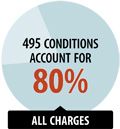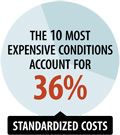Which inpatient pediatric conditions merit priority in comparative effectiveness research?
To answer this question, researchers used detailed administrative and billing data from 38 of the largest freestanding US children's hospitals to identify conditions that met any of these 3 criteria: high cost, high prevalence, or demonstrated high variation of resource use (costs).
To answer this question, researchers used detailed administrative and billing data from 38 of the largest freestanding US children’s hospitals to identify conditions that met any of these 3 criteria: high cost, high prevalence, or demonstrated high variation in resource use (costs).
Among 495 conditions accounting for 80% of all charges, the 10 most expensive conditions accounted for 36% of all standardized costs, either because they were very prevalent (such as pneumonia) or very expensive on a cost-per-encounter basis (such as respiratory distress syndrome in the newborn). Of the 77 most prevalent or costly conditions, 31 showed high variations in costs among hospitals.


Conditions that met all 3 prioritization criteria included hypertrophy of the tonsils and adenoids requiring tonsillectomy or adenoidectomy, otitis media requiring tympanostomy tube placement, and acute appendicitis without peritonitis requiring appendectomy (Keren R, et al. Arch Pediatr Adolesc Med. 2012;166[12]:1155-1164).
Commentary
If you were setting a research agenda for improved and cost-effective care of hospitalized children, where would you start? This article offers an answer. Using a large administrative database and a technique that allows cost comparisons among hospitals as a proxy for use of medical resources, investigators from the Pediatric Research in Inpatient Settings (PRIS) network analyzed more than 3 million admissions to 38 children’s hospitals. Their goal was to find the diagnoses that were most common, most costly, or most variable in use of resources. Measures in variability were sought as an indication that either evidence is lacking as to the best standard approach to a diagnosis or that evidence, although available, isn’t used in implementing standardized care. By identifying frequent, costly admissions with variable care, the authors have drawn a clear target for guideline development, education, and future research. -Michael Burke, MD